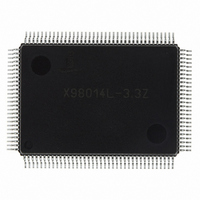X98014L128-3.3-Z Intersil, X98014L128-3.3-Z Datasheet - Page 16

X98014L128-3.3-Z
Manufacturer Part Number
X98014L128-3.3-Z
Description
IC VIDEO DIGITIZER TRPL 128MQFP
Manufacturer
Intersil
Type
Video Digitizer, 3-Channel AFEr
Datasheet
1.X98014L128-3.3-Z.pdf
(29 pages)
Specifications of X98014L128-3.3-Z
Applications
LCD TV/Monitor
Mounting Type
Surface Mount
Package / Case
128-MQFP, 128-PQFP
Rohs Compliant
Yes
Lead Free Status / RoHS Status
Lead free / RoHS Compliant
Available stocks
Company
Part Number
Manufacturer
Quantity
Price
Company:
Part Number:
X98014L128-3.3-Z
Manufacturer:
Intersil
Quantity:
3
Company:
Part Number:
X98014L128-3.3-Z
Manufacturer:
Intersil
Quantity:
1 900
Part Number:
X98014L128-3.3-Z
Manufacturer:
INTERSIL
Quantity:
20 000
Offset can drift significantly over 50°C, reducing image
quality and requiring that the user do a manual calibration
once the monitor has warmed up.
In addition to drift, many AFEs exhibit interaction between
the offset and gain controls. When the gain is changed, the
magnitude of the offset is changed as well. This again
increases the complexity of the firmware as it tries to
optimize gain and offset settings for a given video input
signal. Instead of adjusting just the offset, then the gain, both
have to be adjusted interactively until the desired ADC
output is reached.
The X98014 simplifies offset and gain adjustment and
completely eliminates offset drift using its Automatic Black
Level Compensation (ABLC™) function. ABLC™ monitors
the black level and continuously adjusts the X98014's 10 bit
offset DACs to null out the offset. Any offset, whether due to
the video source or the X98014's analog amplifiers, is
eliminated with 10 bit (1/4 of an 8 bit ADC LSB) accuracy.
Any drift is compensated for well before it can have a visible
effect. Manual offset adjustment control is still available - an
8 bit register allows the firmware to adjust the offset ±64
codes in exactly 1 ADC LSB increments. And gain is now
completely independent of offset - adjusting the gain no
longer affects the offset, so there is no longer a need to
program the firmware to cope with interactive offset and gain
controls.
Finally, there should be no concerns over ABLC™ itself
introducing visible artifacts; it doesn't. ABLC™ operates at a
very low frequency, changing the offset in 1/4 LSB
increments, so it doesn't cause visible brightness
fluctuations. And once ABLC™ is locked, if the offset doesn't
drift, the DACs won't change. If desired, ABLC™ can be
disabled, allowing the firmware to work in the traditional way,
with 10 bit offset DACs under the firmware's control.
Gain and Offset Control
To simplify image optimization algorithms, the X98014
features fully-independent gain and offset adjustment.
Changing the gain does not affect the DC offset, and the
weight of an Offset DAC LSB does not vary depending on
the gain setting.
The full-scale gain is set in the three 8-bit registers (0x06-
0x08). The X98014 can accept input signals with amplitudes
ranging from 0.35V
The offset controls shift the entire RGB input range,
changing the input image brightness. Three separate
registers provide independent control of the R, G, and B
channels. Their nominal setting is 0x80, which forces the
ADC to output code 0x00 (or 0x80 for U and V channels in
YUV mode) during the back porch period when ABLC™ is
enabled.
P-P
to 1.4V
16
P-P
.
X98014
Functional Description
Inputs
The X98014 digitizes analog video inputs in both RGB and
Component (YPbPr) formats, with or without embedded sync
(SOG).
RGB Inputs
For RGB inputs, the black/blank levels are identical and
equal to 0V. The range for each color is typically 0V to 0.7V
from black to white. HSYNC and VSYNC are separate
signals.
Component YUV Inputs
In addition to RGB and RGB with SOG, the X98014 has an
option that is compatible with the component YPbPr and
YCbCr video inputs typically generated by DVD players.
While the X98014 digitizes signals in these color spaces, it
does not perform color space conversion; if it digitizes an
RGB signal, it outputs digital RGB, while if it digitizes a
YPbPr signal, it outputs digital YPbPr. For simplicity’s sake
we will call these non-RGB signals YUV.
The Luminance (Y) signal is applied to the Green Channel
and is processed in a manner identical to the Green input
with SOG described previously. The color difference signals
U and V are bipolar and swing both above and below the
black level. When the YUV mode is enabled, the black level
output for the color difference channels shifts to a mid scale
value of 0x80. Setting configuration register 0x05[2] = 1
enables the YUV signal processing mode of operation.
The X98014 can optionally decimate the incoming data to
provide a 4:2:2 output stream (configuration register
0x18[4] = 1) as shown in Table 2.
SIGNAL
SIGNAL
INPUT
INPUT
Y
U
V
Y
U
V
TABLE 1. YUV MAPPING (4:4:4)
TABLE 2. YUV MAPPING (4:2:2)
CHANNEL
CHANNEL
X98014
X98014
INPUT
INPUT
Green
Green
Blue
Blue
Red
Red
ASSIGNMENT
ASSIGNMENT
OUTPUT
OUTPUT
X98014
X98014
Green
Green
Blue
Blue
Red
Red
U
U
Y
V
Y
driven low
OUTPUT
OUTPUT
SIGNAL
SIGNAL
0
0
0
0
0
U
March 8, 2006
Y
V
Y
V
1
1
1
1
1
Y
U
V
Y
U
FN8217.3
2
2
2
2
2
Y
V
Y
U
V
3
3
3
3
3













